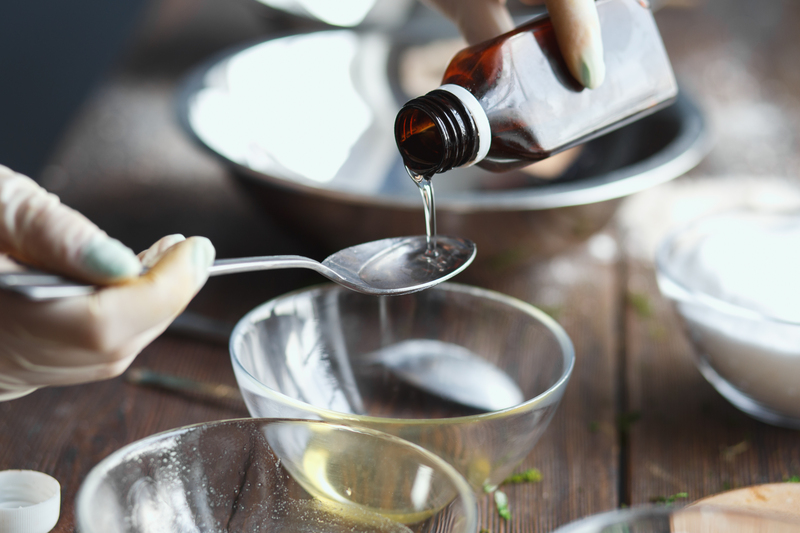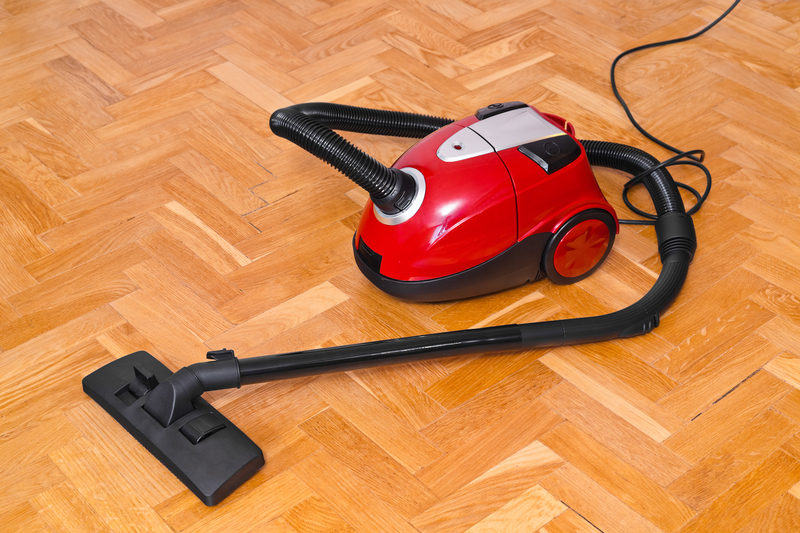Clean with Confidence: Tackling Stovetop Burnt-on Residue
Posted on 22/05/2025
Clean with Confidence: Tackling Stovetop Burnt-on Residue
If you're tired of staring at unsightly burnt-on residue on your stovetop, struggling with harsh scrubbing, or simply want a cleaner and shinier kitchen, you've come to the right place. In this comprehensive guide, you'll discover expert tips, effective cleaning methods, and actionable advice to help you clean your stovetop with confidence. Whether you have a gas, electric, or glass stovetop, you'll learn how to make burnt-on messes a thing of the past.

Why Do Burnt-on Stovetop Stains Happen?
Before you can effectively clean your burnt-on stovetop residue, it's essential to understand how these stubborn stains happen in the first place:
- Boil-overs: Unattended pots or pans can easily bubble over, leaving behind sticky, stubborn spots.
- Spills and splatters: Sauces and soups tend to jump out of the pan and bake onto your stove when exposed to heat.
- Grease accumulation: Fats and oils can splatter and, when not cleaned immediately, harden into difficult stains.
- High heat exposure: Excessive heat can turn minor spills into tough, burnt-on residue within minutes.
Understanding these causes can help prevent future messes, but even with the best intentions, accidents happen. That's why it's important to have a reliable cleaning strategy.
What Makes Burnt-on Residue So Challenging to Remove?
Burnt-on food and grease have been exposed to intense heat, which causes them to carbonize and bond with the stovetop surface. This makes them much more difficult to remove compared to fresh spills. The level of difficulty depends on the stovetop material, the type of food, and how long the residue has been left unattended.
To successfully clean stubborn stove stains, you need the right techniques, tools, and cleaners--preferably ones that do not damage your appliance or require excessive effort.
Best Techniques for Cleaning Burnt-on Stovetop Residue
1. Preparation Is Key
Start by turning off and unplugging your stove. Wait until the surface has cooled completely to avoid burns or injuries. Remove any burner grates, knobs, and removable components.
2. Choose the Right Cleaning Tools
- Non-abrasive scrubbers: Avoid steel wool or scouring pads that can scratch the surface, especially for glass and ceramic stovetops.
- Soft cloths or sponges: Microfiber cloths are perfect for wiping away loosened debris.
- Plastic or silicone scrapers: These can safely dislodge tough, burnt-on gunk without scratching.
3. Recommended Cleaners for Different Stovetops
- Gas stovetops: Use a mixture of warm water and gentle dish soap for grates and drip pans. For heavy residue, baking soda and vinegar are excellent low-abrasive solutions.
- Glass and ceramic stovetops: Opt for a specialty glass stovetop cleaner or a homemade paste of baking soda and water. Avoid rough scrubbing tools.
- Electric coil stovetops: Remove coils carefully and clean drip pans separately. Use gentle dish soap and water for the surface.
4. Effective Home Remedies for Burnt-on Stovetop Messes
- Baking Soda Paste: Mix equal parts baking soda and water to form a thick paste. Spread over the stained area and let sit for 15-30 minutes, then gently scrub.
- White Vinegar Spray: Fill a spray bottle with equal parts white vinegar and water. Spray directly onto the burnt residue, let it fizz, then wipe away.
- Lemon Juice: Lemon's natural acidity helps break down grease and adds a refreshing scent to your kitchen.
- Hydrogen Peroxide (for tough stains): Apply to the stain, sprinkle with baking soda, and allow the mixture to bubble before scrubbing clean.
Step-by-Step Guide: How to Clean Burnt-On Residue from Your Stovetop
Step 1: Remove Grates and Burner Covers
Carefully lift off removable parts. Soak them in hot, soapy water while you address the stovetop surface. This will help soften burnt food debris and make cleaning easier.
Step 2: Loosen Surface Debris
Wipe away loose crumbs or food particles with a damp cloth. Spray the stovetop with a mix of vinegar and water, letting it sit for several minutes to soften tough stains.
Step 3: Apply Cleaning Solution
Spread baking soda paste over the burnt-on areas. For glass stovetops, be sure the surface is cool and dry before applying. Let the paste sit for up to 30 minutes to break down the residue.
Step 4: Gently Scrub (Don't Scratch!)
Using a non-abrasive scrubber or a microfiber cloth, gently rub the stained spots. If your stove has a glass top, use a specialized scraper at a 45-degree angle to avoid scratching. Repeat as necessary for stubborn patches.
Step 5: Wipe and Rinse Thoroughly
Remove any leftover cleaner and debris with a clean, damp cloth. Dry with a soft towel to leave your stovetop streak-free and gleaming.
Step 6: Deep Clean Grates and Drip Pans
After soaking, scrub grates and pans with a brush. For lingering stains, apply baking soda and a small amount of vinegar. Dry completely before replacing on the stove.
Special Tips for Specific Stovetop Types
Cleaning Gas Stovetops
- Remove grates: Soak in hot, soapy water to loosen residue.
- Scrub carefully: Use a soft-bristle brush to remove carbonized food.
- Clean burner heads: Use a needle or pin to unclog tiny holes, but avoid damaging the metal.
Maintaining Glass and Ceramic Stovetops
- Avoid heavy pots: Dropping or dragging cookware can crack the glass.
- Immediate cleanup: Wipe spills as soon as the surface cools to prevent burnt-on build-up.
- Use specialty cleaners: Choose products marked safe for glass to avoid haze or damage.
Handling Electric Coil Stovetops
- Remove coils: Always ensure coils are completely cool and disconnected.
- Clean drip pans: Soak and scrub them out of the stove to avoid damaging electrical components.
How to Prevent Burnt-on Stovetop Stains
- Wipe up spills promptly: Clean fresh spills before they bake onto the surface.
- Cook with lids on: This reduces splatter and boil-over.
- Monitor food closely: Prevent pots from boiling dry or overflowing.
- Use splatter guards: These simple tools significantly minimize messes when frying or simmering.
- Make it a habit: Add quick stovetop wipes to your nightly kitchen routine for consistent cleanliness.
Common Cleaning Mistakes to Avoid
- Using abrasive pads: These can scratch enamel, glass, or steel surfaces, causing permanent damage.
- Overusing harsh chemicals: Ammonia and bleach can degrade finishes and are unsafe for food-contact surfaces.
- Ineffective dry scrubbing: Without a soaking step, you're just smearing burnt-on food, not removing it.
- Skipping manufacturer instructions: Always read your stovetop's user manual to avoid voiding warranties or causing damage.
When to Call a Professional
If you've tried every trick and burnt-on stove residue just won't budge, or if you're dealing with stubborn stains on delicate glass or high-end finishes, it may be time to contact a cleaning professional. A specialized technician has access to commercial-grade tools and cleaners that are safe for sensitive surfaces.
Best Products for Cleaning Burnt-on Stovetop Messes
- Bar Keeper's Friend: A gentle abrasive cleaner safe for most surfaces, including stainless steel and ceramic.
- Weiman Glass Cook Top Cleaner: Perfect for glass and ceramic surfaces, leaving a streak-free shine.
- Mr. Clean Magic Eraser: For tough spots, the micro-scrubbers erase scorch marks efficiently.
- Baking Soda and Vinegar Combo: Budget-friendly, natural, and highly effective for most kitchen cleaning needs.
Clean with Confidence: A Sparkling Stovetop, Step by Step
Armed with these stovetop cleaning tips, you can tackle even the toughest burnt-on residue with confidence and ease:
- Act promptly: Address spills and splatters as soon as possible.
- Use gentle abrasives: Protect your stovetop's finish to maintain its appearance for years.
- Routinely deep clean: Make thorough cleanings part of your monthly kitchen routine.
- Invest in specialty cleaners: Products labeled for your stove's surface can speed up cleaning and prevent unforeseen damage.

Frequently Asked Questions About Cleaning Burnt-on Stovetops
Can burnt-on stains be removed from any stovetop?
In most cases, yes--using the right methods and a little patience, nearly any stovetop can be restored to shine. Severe, long-ignored stains on sensitive glass or ceramic may require professional intervention.
What's the safest homemade remedy for burnt-on stovetop gunk?
A paste of baking soda and water is safe, effective, and gentle enough for any stovetop surface.
How often should I clean my stovetop?
Ideally, wipe away small spills every day and perform a deep clean at least once a week. The more you cook, the more frequently you should clean!
How do I avoid streaks on glass stovetops?
Always rinse thoroughly and dry with a lint-free microfiber cloth after cleaning. Avoid oily cleaners that can leave behind residue.
Conclusion: Enjoy a Spotless Stovetop Every Day
When you apply these burnt-on stovetop cleaning techniques, maintaining a beautiful, spotless kitchen becomes a stress-free routine. Remember: prevention is the best cure, but when spills happen, act fast and use the right combination of gentle abrasives, safe scrubbing tools, and specialty or DIY cleaners for the job.
With the right know-how, the days of dreading burnt-on residue are over. You can now clean your stovetop with confidence and keep your cooking space shining every time you step into your kitchen!





